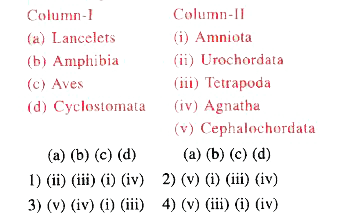Match column I with column II and select the correct option from the given codes.
Column IColumn IIA. Vessels(i). Cells are living, with thin cellulosic cells wallsB. Tracheids(ii). Cells possess highly thickened walls with obliterated central lumenC. Xylem fibres(iii). Individual members are interconnected through perforations in their common wallsD. Xylem parenchyma(iv). Elongated tube-like cells with thick, lignified walls and tapering ends
A-(iv),B-(iii),C-(ii),D-(i)
A-(iii),B-(iv),C-(ii),D-(i)
A-(ii),B-(iii),C-(iv),D-(i)
A-(iv),B-(ii),C-(iii),D-(i)
The correct Answer is:B
To solve the matching question between Column I and Column II, we need to analyze the characteristics of each xylem component listed in Column I and match them with the appropriate descriptions in Column II.
1. Identify the components in Column I:
- A. Vessels
- B. Tracheids
- C. Xylem fibres
- D. Xylem parenchyma
2. Analyze each component and its characteristics:
- A. Vessels: These are specialized structures in xylem that are responsible for the conduction of water. They have thick walls and an obliterated central lumen (the central space is not functional for living cells).
- B. Tracheids: These are elongated cells in the xylem that also help in water conduction. They have perforations in their side walls that allow for water movement between cells.
- C. Xylem fibres: These are supportive cells that have thick, lignified walls and tapering ends. They provide structural support to the plant.
- D. Xylem parenchyma: This is the only living cell type in the xylem. It has thin cell walls made of cellulose and contains protoplasm.
3. Match each component with the correct description:
- A. Vessels match with (ii): "Cells possess highly thickened walls with obliterated central lumen."
- B. Tracheids match with (iii): "Individual members are interconnected through perforations in their common walls."
- C. Xylem fibres match with (iv): "Elongated tube-like cells with thick, lignified walls and tapering ends."
- D. Xylem parenchyma match with (i): "Cells are living, with thin cellulosic cell walls."
4. Final Matching:
- A → (ii)
- B → (iii)
- C → (iv)
- D → (i)
5. Select the correct option based on the matches:
- The correct option is: A-2, B-3, C-4, D-1.
- A. Vessels
- B. Tracheids
- C. Xylem fibres
- D. Xylem parenchyma
- A. Vessels: These are specialized structures in xylem that are responsible for the conduction of water. They have thick walls and an obliterated central lumen (the central space is not functional for living cells).
- B. Tracheids: These are elongated cells in the xylem that also help in water conduction. They have perforations in their side walls that allow for water movement between cells.
- C. Xylem fibres: These are supportive cells that have thick, lignified walls and tapering ends. They provide structural support to the plant.
- D. Xylem parenchyma: This is the only living cell type in the xylem. It has thin cell walls made of cellulose and contains protoplasm.
- A. Vessels match with (ii): "Cells possess highly thickened walls with obliterated central lumen."
- B. Tracheids match with (iii): "Individual members are interconnected through perforations in their common walls."
- C. Xylem fibres match with (iv): "Elongated tube-like cells with thick, lignified walls and tapering ends."
- D. Xylem parenchyma match with (i): "Cells are living, with thin cellulosic cell walls."
- A → (ii)
- B → (iii)
- C → (iv)
- D → (i)
- The correct option is: A-2, B-3, C-4, D-1.
Topper's Solved these Questions
- BOOK - NCERT FINGERTPS ENGLISHCHAPTER - ANATOMY OF FLOWERING PLANTSEXERCISE - Assertion & Reason15videos
ANATOMY OF FLOWERING PLANTS
- BOOK - NCERT FINGERTPS ENGLISHCHAPTER - ANATOMY OF FLOWERING PLANTSEXERCISE - Anatomy Of Flowering Plants143videos
ANATOMY OF FLOWERING PLANTS
- BOOK - NCERT FINGERTPS ENGLISHCHAPTER - ANIMAL KINGDOMEXERCISE - Animal Kingdom148videos
ANIMAL KINGDOM
Similar Questions
Match column I with column II and select the correct option from the given codes.
Column IColumn IIA. Salivary amylase(i)ProteinsB. Bile salts(ii)Milk proteinsC. Rennin(iii)StarchD. Pepsin(iv)LipidsView SolutionMatch column I withcolun II and select the correct option from the given codes.
Column IColumn IIA. Bulliform cells(i). Regulate opening and closing of stomataB. Guard cells(ii). Aerating pores in the bark of plantC. Lenticels(iii). Rolling in and out leavesD. Subsidiary cells(iv). Accessory cellsView Solution
Knowledge Check
- Question 1 - Select One
Match column I with II column II and select the correct option from the given codes .
 AA-(ii), B-(iii), C-(iv), D-(i)BA-(iii), B-(ii), C-(i), D-(iv)CA-(iii), B-(ii), C-(iv), D-(i)DA-(i), B-(ii), C-(iii), D-(iv)
AA-(ii), B-(iii), C-(iv), D-(i)BA-(iii), B-(ii), C-(i), D-(iv)CA-(iii), B-(ii), C-(iv), D-(i)DA-(i), B-(ii), C-(iii), D-(iv) - Question 2 - Select One
Match column I and II and select the correct option from the given codes.
 AA-(iii),B-(iv),C-(i), D-(v), E-(ii)BA-(iii),B-(i),C-(iv), D-(v), E-(ii)CA-(iii),B-(iv),C-(v), D-(i), E-(ii)DA-(ii),B-(iv),C-(i), D-(v), E-(iii)
AA-(iii),B-(iv),C-(i), D-(v), E-(ii)BA-(iii),B-(i),C-(iv), D-(v), E-(ii)CA-(iii),B-(iv),C-(v), D-(i), E-(ii)DA-(ii),B-(iv),C-(i), D-(v), E-(iii) - Question 3 - Select One
Mathc column I with column II and select the correct option from the given codes.
 AA-(ii), B-(iii), C-(iv), D-(i), E-(v)BA-(v), B-(iv), C-(iii), D-(i), E-(ii)CA-(i), B-(iii), C-(iv), D-(ii), E-(v)DA-(i), B-(iv), C-(iii), D-(ii), E-(v)
AA-(ii), B-(iii), C-(iv), D-(i), E-(v)BA-(v), B-(iv), C-(iii), D-(i), E-(ii)CA-(i), B-(iii), C-(iv), D-(ii), E-(v)DA-(i), B-(iv), C-(iii), D-(ii), E-(v)
Match column I withcolun II and select the correct option from the given codes.
Column IColumn IIA. Bulliform cells(i). Regulate opening and closing of stomataB. Guard cells(ii). Aerating pores in the bark of plantC. Lenticels(iii). Rolling in and out leavesD. Subsidiary cells(iv). Accessory cellsView SolutionMatch column I with column II and select the correct option from the gives codes.
ColumnIColumnIIA.Wings(i)ReptilesB.Operculum(ii)ChondrichthyesC.Scutes(iii)BirdsD.Cartilaginous endoskeletion(iv)OsteichthyesView SolutionMatch the items given in Column - I with those in Column - II and select the correct option from the codes given below .
 View Solution
View SolutionMathc column I with column II and select the correct option from the given codes.
 View Solution
View SolutionMathc column I with column II and select the correct option from the given codes.
Column IColumn IIMucous neck cells(i)HCl,intrinsic factorPeptic//chief cells(ii)MucusPariental//Oxyntic cells(iii)PepsinogenView Solution

